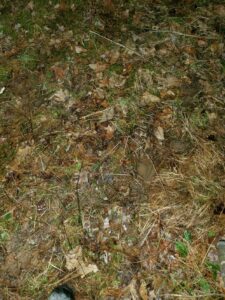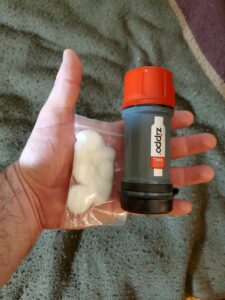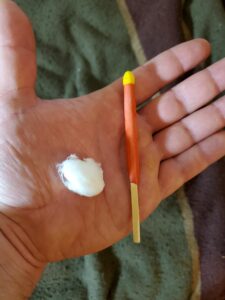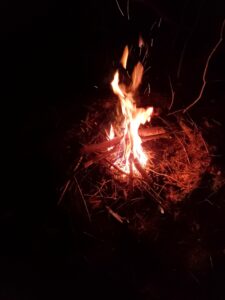The standard lecture goes like this: If you are going into any kind of wilderness for any reason you need to be able to make fire. To ensure you can make fire, you should bring a fire kit. A fire kit should have a lighter, a Ferro rod, matches, and tinder. This same basic lecture is repeated by all the reputable outdoor skill guys with minor variations. Some people like Dan are satisfied with this basic trio if they are just out and exploring. But Lonnie (who lives in Alaska) adds a road flare to his kit in case he ever needs a fire instantaneously. Josh takes things even further. He seems to strive to have as many possible ways of starting a fire in a small as possible kit. Regardless of how they differ, they all have the lighter, ferro rod, matches, and tinder at the core of their kit.
What I don’t understand at an intuitive level is why the matches? In the theoretical sense, I understand why. More ways of starting a fire are always better. And a good match has fire starting and tinder all bound up in one. But on the logic that more ways of starting a fire are better, I want to have a MAPP torch along with me as well. The reason I don’t carry a MAPP torch is because it weighs too much to be worth what a MAPP torch has to offer.
Now the opportunity cost to carry matches is not anywhere close to being as extreme as that of carrying matches. Nonetheless, in the space that matches takes up, you could have brought something else along. So to my mind, the question is why would I want to bring matches along instead of another lighter or some extra tinder? What does matches have to offer that bringing more of something else can’t compensate for?
Part of the reason I have these questions is that up until this test, I had never started a fire with matches so I had no practical basis of comparison. So for this test, I elected to try to start a fire in as similar conditions as possible between a match and lighter.
Conditions: Temp was 31 degrees and everything was mud and water as you can see from the below picture. It had been a beautiful day and the sky was clear with no wind. But that did not do me a lot of good as I started and completed this in the dark. I had too much stuff going on during the day and doing this at night was the only way I could get enough time to do this right.
Test: Start a fire with just a match and no artificial tinder (success). Start a fire with a lighter and no artificial tinder (success).
Equipment: A Zippo Typhoon Match Kit, A BIC Lighter, a Silky Pocket Boy Saw, and a Surefire Stiletto Flashlight.
Equipment Digression:
Reason For Surefire Stiletto Flashlight: I wanted this test to be a straight up comparison between the Zippo Typhoon Matchs and a BIC lighter and not some kind of struggle in the dark. To make sure I did not have to struggle in the dark I brought along my Surefire Stiletto. I could have used a headlamp and in fact most of the time I used the Stiletto as a headlamp by clipping it to my hat. The main reason for the Stiletto is that it has a better throw then my headlamps and so for tasks where I wanted to look around for dead branches still attached to trees it was the better option and since it did not get in the way of the close in work, I used it the entire time.
Discussion Of Matches In General And The Typhoon Match Kit In Particular:
As a general rule, only old people carry regular strike anywhere matches into the wilderness anymore. If you look at the various fire kits I linked in the introductory paragraphs, only Lonnie the oldest (and most likely the poorest) of the three of them had any “normal” matches in his kit and even he had storm matches mixed in his match container. Everyone else was focused exclusively on “Storm Matches.”
The problem with normal matches is they can absorb moisture for the air and stop working, they can be easily blow out by the wind, and can be broken or smashed if not protected. Really the only thing that an old school match had over a lighter was that they worked when cold and did not evaporate away in storage as lighter can do.
By contrast, a modern storm match will not get blown out and will not be put out by a little water. Below you can see this being demonstrated with both the Zippo Typhoons (the type I used for this test) and the UCO Titians.
The general consensus seems to be that the UCO Titians are better but unlike the above video, there are plenty of examples of the Typhoons relighting after being dunked as well. But it does seem consistent across comparisons that they have more difficulty relighting themselves into visible flame.
Regardless of the differences at the margin, both matches are very impressive. They are a flame starter and a tinder all in one package. They are capable of starting even water logged kindling if you so choose as the below video shows.
But as impressive as they are, they have a number of downsides. For one, they need a striker and that striker typically does not do well wet. For another, even though they can light when wet, the presence of water will break them down over time so you need to protect them from moisture and high humidity if you want them to stay good over time. And of course, they can be broken or crushed. All these things mean that some kind of strong water tight case is needed if you want to carry these things and have them be a reliable means of starting a fire.
It is because the case is a critical part of the reliability of these types of matches that I went with the Zippo Typhoons (although I might restock with the UCO if I ever run out). To me it seems like the Zippo case is a more fool proof system if you are a klutz like me and using it in the dark or when freezing for reasons mentioned in the comparison video. And the quality of the carrying case gives me a reasonable degree of confidence that these matches will work when I need them to.
The downside of this confidence means that to carry this kind of fire starting ability you wind up carrying a fairly large package compared to some other options. As an example, below is my bag of favorite tinder compared to the size of my match carrying case.
Of course, you could figure out how to carry those matches in a smaller numbers in some other protected means, but the matches themselves are unavoidably large. Below is a comparison between one cotton ball and one match.
I compare the matches to tinder because in my view the main advantage that matches have over other fire starting methods is that they can serve as their own tinder. But if you have tinder and both a ferro rod and a lighter you pretty much have everything that a match has to offer. Or at least that is how it seems to me on a purely intellectual level.
But I don’t have a lot of practical experience and I was required to have some kind of storm matches for a course (never used them though). So since I have them, I might as well experiment with them to figure out what I do not understand.
Narrative for the Test:
I did not start the clock until I was at the place I wanted to start a fire. Since I was using a folding saw and a good flashlight, everything went really fast. I located a large dead branch sheltering under its still living siblings on an evergreen tree. I cut it off and broke it down into various sizes of kindling. I lit a match and stuck it under a pile of the smaller twigs. The fire took right off and it was no trouble to start adding larger stuff to it. It was 11 minutes from when I arrived on site until I had a fire like this…..
For the next fire, I got the same amount and type of kindling as I had for the match fire. I only started the clock after the kindling was gathered because all I was interested in was how much longer it was going to take the lighter alone to get a fire to the same point as the match.
I had thought that I would have to use a knife or something since the last time I tried a “lighter only” test I had failed to get a fire started. But with more practice under my belt since then, I figured I would have a another shot at doing with just a lighter before I went for the knife.
While the clock was running I made a small torch like bundle out of the smallest wispiest twigs I had. Instead of trying to light these on the ground like last time I held it up in the air. At first I held this bundle horizontally and nothing would stay burning. But then I stopped being dumb and held the bundle so that the sticks in it ran vertically and lit it from the bottom. In no time the little bundle caught and it took the bundle a few seconds to really get going. But once the bundle was going I laid it down and put the rest of my kindling on it and soon had a fire like the below……
It took two minutes longer to make the above fire then it did the one with the matches.
Times: 11 minutes to make a fire with a Zippo Typhoon match. Two minutes longer to make a similar fire with a lighter alone.
Lesson Learned:
1. Even just a little practice is making me better. Just a short time ago I could not start a fire with a lighter alone in similar conditions.
2. The matches are certainly a good choice for those with little experience and who need to start a fire in an emergency. If this same test had been run by someone with little experience, I don’t think the times between the two test would have been near as close (see lesson number #1). For this reason, I don’t regret putting them on my emergency FEMA kit for Yuppie’s packing list.
All that said, I am still not sure that for me they are worth carrying in place of having more tinder or having some candles or any of the other things I could be carrying. I think I could fit two lighters, a bunch of cotton balls, and one small ferro rod striker combo in the same case all these matches came in. Based on my limited experience and what little I know, it seems like a better deal for me than the matches. But my experience is limited to this one test. I should do some more tests in more adverse conditions before I get dogmatic on this point.





